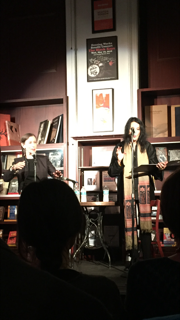I requested doing some work with octave multiphonics, as it was something I was struggling to do consistently in my practice. We started with C (in the staff and two lines above the staff). I was moving the vowel shape in my mouth from “ooh” on the low note alone, “ahh” on the high note alone, and something like “eye/ö” for the octave sounding together. Robert helped refine those vowel shapes and the lip placement as well. For the low note, he suggested feeling the air and sound more in my sinuses while funneling the air deeper into the flute, which gave the low C a much more colorful and individualized sound. For the octave together, I needed to open my mouth more while maintaining the ö-type vowel, and also keep my top lip down. It’s important to practice these at a soft dynamic to avoid using purely the air speed as the “oomph” to achieve the multiphonic. From there, we moved on to large multiphonics. The key to these is to start loud, getting the intervals sounding simultaneously through the use of a lot of fast air. It is much easier to back off from that beginning point than to build up to the loud.
We listened to part of an album by Otha Turner and the Afrossippi Allstars, which was pretty legit. Otha also plays more traditional drum and fife music, and the recordings have a very field-recording vibe. The ethnomusicologist in me appreciates them. And speaking of ethnomusicology, Robert shared a way to make the western flute sound more like a Chinese flute: by putting cigarette/pad paper under the open-holed keys. This essentially makes the flute act like a kazoo. Robert may or may not have secretly tuned once in high school using this method and tone quality.
There were some parts of Sequenza I wanted to work on as well. We started with transitioning from a normal note to its whisper tone, as is found with high B-flat in the piece; I am here to tell you that if you practice your whistle tones in a variety of ways and for a variety of notes, it will work wonders when put into context. I surprised myself with how smoothly I could transition from the normal note to the whisper tone.
There is a gesture in the sixth system on the third page of the piece where the bar extends past the last note in the group; this is the only time this occurs in the entire piece, and Robert interprets the marking as crescendo-ing to an abrupt stop, possibly even using the tongue to stop the sound. Later on page three, there is our first harmonic, to be played at pppp. Because we don’t want to give away the quality of sound for the upcoming multiphonic based on the same fundamental note (C), Robert suggests using a variation other than the low C fingering for this harmonic. The one I’ve chosen to use is the low C fingering without the left thumb depressed. There is a high F-sharp halfway through the fourth page where altering the fingering again aids with its context; in this case, using the middle finger instead of the ring finger on the right hand is an apt choice. A few notes later, there is a high C, which can be colored by using the low B foot keys with the right hand pinky.
We also discussed grouping the grace note figures. Especially in the cases where there are more than four grace notes at a time, planning out how they belong together will help in executing them.
Some of the notes that are fluttertongued throughout the piece also have accents or other articulation markings. If you’re able to use uvular fluttering, then each note, marked or not, will be tongued regardless, so this is not an issue. But if you’re still practicing the uvular flutter (like me), re-tonguing the accented notes while using the tongue flutter is the best way to achieve the desired effect.
On the last page of Sequenza, we see again the notation of four dots above a note head to indicate that it should be tongued four times. Robert prefers to elongate the four repetitions of the note (if it is long, like the last B-natural) instead of tonguing consistently through the duration of the note. For the last line, his words of wisdom are to stay engaged physically, especially in the abdominals, before the attack of the low C-sharp. And continue that support while decrescendo-ing to properly sound the very last, and surprising, C-natural grace note.
Other things:
- It’s time to invest in some actual winter boots
- My mom is shipping me another blanket
- I consistently practice with hand warmers
- The above list makes me think that … winter is coming.
- And so is Gilmore Girls: A Year in the Life!!!
Until next time!

